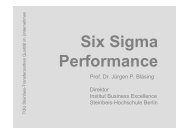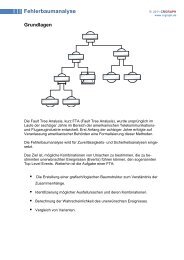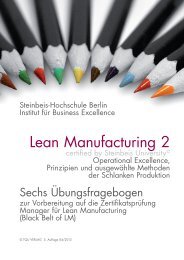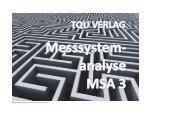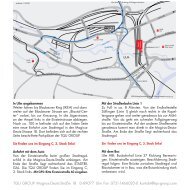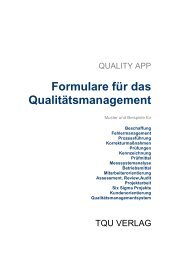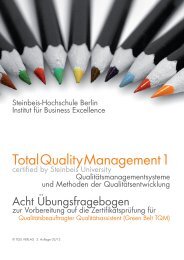View a Sample of the Black Belt Memory Jogger - Goal - QPC
View a Sample of the Black Belt Memory Jogger - Goal - QPC
View a Sample of the Black Belt Memory Jogger - Goal - QPC
Create successful ePaper yourself
Turn your PDF publications into a flip-book with our unique Google optimized e-Paper software.
IMPROVING THE WAY ORGANIZATIONS RUN
The<br />
BLACK<br />
BELT<br />
<strong>Memory</strong><br />
<strong>Jogger</strong> TM<br />
A Pocket Guide for<br />
Six Sigma Success<br />
Six Sigma Academy<br />
First Edition<br />
GOAL/<strong>QPC</strong>
The <strong>Black</strong> <strong>Belt</strong> <strong>Memory</strong> <strong>Jogger</strong><br />
© 2002 by GOAL/<strong>QPC</strong> and Six Sigma Academy.<br />
All rights reserved.<br />
Reproduction <strong>of</strong> any part <strong>of</strong> this publication without <strong>the</strong><br />
written permission <strong>of</strong> GOAL/<strong>QPC</strong> is prohibited.<br />
Six Sigma is a federally registered trademark <strong>of</strong> Motorola, Inc.<br />
MINITAB is a trademark <strong>of</strong> Minitab, Inc.<br />
Six Sigma Academy<br />
Therese Costich-Sicker, Project Manager<br />
Paul Sheehy, Writer<br />
Philip Samuel, Ph.D., Copy Editor<br />
Daniel Navarro, Writer<br />
Terry Ziemer, Ph.D., Copy Editor<br />
Robert Silvers, Writer<br />
Victoria Keyes, Writer<br />
Shannon Godden, Copy Editor<br />
John Dziark, Copy Editor<br />
Tylar Burton, Copy Editor<br />
Marcia Lemmons, Copy Editor<br />
Deb Dixon, Writer<br />
GOAL/<strong>QPC</strong><br />
Daniel Picard, Editor<br />
Danielle Page, Production<br />
Michele Kierstead, Cover Design, Graphics, and Layout<br />
Bob Page, Project Manager<br />
GOAL/<strong>QPC</strong><br />
12B Manor Parkway, Salem, NH 03079-2862<br />
Toll free: 800-643-4316 or 603-893-1944<br />
Fax: 603-870-9122<br />
E-mail: service@goalqpc.com<br />
Web site: www.goalqpc.com<br />
Printed in <strong>the</strong> United States <strong>of</strong> America<br />
First Edition 10 9 8 7 6 5 4<br />
ISBN 1-57681-043-7
Table <strong>of</strong> Contents<br />
Introduction .................................................................. 1<br />
Roles and Responsibilities .......................................... 7<br />
Project Management .................................................. 11<br />
Critical To Flowdown ............................................... 19<br />
Basic Statistics ............................................................. 33<br />
Process Maps .............................................................. 49<br />
Rolled Throughput Yield .......................................... 55<br />
Sigma Values .............................................................. 61<br />
Cause & Effect/Fishbone Diagram ......................... 65<br />
Measurement Systems Analysis .............................. 73<br />
Capability Indices ...................................................... 95<br />
Graphical Analysis .................................................. 101<br />
Multi-Vari Charts ..................................................... 127<br />
Central Limit Theorem ............................................ 139<br />
Confidence Intervals ............................................... 143<br />
Hypo<strong>the</strong>sis Testing .................................................. 149<br />
Transforming Data ................................................... 157<br />
Correlation and Regression .................................... 167<br />
Binary Logistic Regression ..................................... 179<br />
Design <strong>of</strong> Experiments ............................................ 185<br />
Failure Mode and Effects Analysis ....................... 211<br />
Control Charts .......................................................... 221<br />
Total Productive Maintenance and Preventative<br />
Maintenance ............................................................. 237<br />
Control Plan .............................................................. 241
Introduction<br />
What is Six Sigma<br />
The Six Sigma methodologies are a business<br />
philosophy and initiative that enables world-class<br />
quality and continuous improvement to achieve <strong>the</strong> highest<br />
level <strong>of</strong> customer satisfaction. Metrics are established that<br />
align an organization’s strategic goals and values to<br />
that <strong>of</strong> <strong>the</strong>ir customer’s needs and expectations.<br />
Sigma (σ) represents a unit <strong>of</strong> measurement that designates<br />
<strong>the</strong> distribution or spread about <strong>the</strong> mean (average) <strong>of</strong> a<br />
process. In business, a sigma value is a metric that represents<br />
how well a process is performing and how <strong>of</strong>ten a defect<br />
is likely to occur. The higher <strong>the</strong> sigma value, <strong>the</strong> less<br />
variation and fewer defects <strong>the</strong> process will have. Six<br />
Sigma is <strong>the</strong> new standard <strong>of</strong> excellence at only 3.4<br />
defects per million opportunities (DPMO).<br />
How does it work<br />
The Six Sigma philosophy uses data and statistical<br />
tools to systematically improve processes and sustain<br />
process improvements. Process metrics are evaluated<br />
based on a comparison <strong>of</strong> average and variation to<br />
performance specifications or targets.<br />
The methodology is a project-focused approach<br />
consisting <strong>of</strong> five phases: Define, Measure, Analyze,<br />
Improve, and Control. Projects are selected and Defined<br />
from business, operational, and customer needs, based<br />
on <strong>the</strong>ir linkage to executive strategies. In <strong>the</strong> Measure<br />
phase, tools are applied to validate <strong>the</strong> measurement<br />
system and to characterize <strong>the</strong> process. In <strong>the</strong> Analyze<br />
and Improve phases, sources <strong>of</strong> variation are identified,<br />
a statistical relationship between <strong>the</strong> process input and<br />
©2002 GOAL/<strong>QPC</strong>,<br />
Six Sigma Academy<br />
Introduction 1
output variables is established, and <strong>the</strong> process<br />
performance is optimized. The Control phase applies<br />
traditional and statistical tools to sustain process<br />
improvements. Emphasis is placed on controlling <strong>the</strong> key<br />
process inputs to consistently achieve key process outputs.<br />
The DMAIC Model<br />
What is it<br />
The DMAIC model is a set <strong>of</strong> tools outlined in five<br />
phases that are used to characterize and optimize both<br />
business and industrial processes. Each project must<br />
complete <strong>the</strong> five phases in chronological order.<br />
Define Phase<br />
In <strong>the</strong> Define phase, <strong>the</strong> customer needs are stated and<br />
<strong>the</strong> processes and products to be improved are identified.<br />
Steps Activities/Tools Output(s)<br />
Create • Define process to • Problem statement<br />
problem improve • Project scope<br />
statement • Define project • Project goals<br />
objectives<br />
• Identify project<br />
stakeholders<br />
• Identify customers<br />
Identify • CT Trees • Identified customer<br />
CTQs<br />
needs<br />
Define • Identify performance • Gap analysis<br />
performance measures • Business impact<br />
standards • Financial analysis (project savings)<br />
• High-level process<br />
mapping<br />
• Project definition<br />
• Project charter<br />
• Project plan/<br />
timeline<br />
• High-level process<br />
map<br />
• Definition <strong>of</strong><br />
performance<br />
measures<br />
2 Introduction ©2002 GOAL/<strong>QPC</strong>,<br />
Six Sigma Academy
Measure Phase<br />
The Measure phase determines <strong>the</strong> baseline and target<br />
performance <strong>of</strong> <strong>the</strong> process, defines <strong>the</strong> input/output<br />
variables <strong>of</strong> <strong>the</strong> process, and validates <strong>the</strong><br />
measurement systems.<br />
Steps Activities/Tools Output(s)<br />
Understand • Process-map <strong>the</strong> as-is • Detailed process<br />
process and process map<br />
validate • Identify process • Identified process<br />
measurement inputs/outputs output variables<br />
system • Collect data (POV) – (y’s) and<br />
• Evaluate measurement <strong>the</strong>ir measurements<br />
system <strong>of</strong> process y’s • Identified process<br />
input variables (PIV)<br />
– (x’s)<br />
• Validated<br />
performance data<br />
• Measurement system<br />
capability on y’s<br />
• Data collection/<br />
sampling plan<br />
Determine • Control charts on • Baseline control<br />
process process y’s charts<br />
capability • Capability analysis • Baseline capability<br />
• Graphical techniques • DPMO<br />
• Z value<br />
Finalize • Cause and effect • Revised project<br />
performance analysis goals<br />
objectives • Create FMEA • Quantified project<br />
• Review <strong>of</strong> project objectives<br />
goals and plan • Validated financial<br />
goals<br />
• Revised project<br />
plan<br />
• Cause and effect<br />
relationships<br />
• Prioritized risk<br />
©2002 GOAL/<strong>QPC</strong>,<br />
Six Sigma Academy<br />
Introduction<br />
3
Analyze Phase<br />
The Analyze phase uses data to establish <strong>the</strong> key process<br />
inputs that affect <strong>the</strong> process outputs.<br />
Steps Activities/Tools Output(s)<br />
Identify • Detailed process map • Identified sources<br />
sources <strong>of</strong> • Brainstorming <strong>of</strong> variation<br />
variation • Fishbone diagram • Identified potential<br />
• Cause & Effect leverage variables<br />
Matrix<br />
(KPIVs)<br />
• FMEA<br />
• Updated process<br />
• SPC on x’s and y’s map<br />
• MSA on x’s<br />
• Updated FMEA<br />
Screen • Graphical analysis • Potential x’s critical<br />
potential • Hypo<strong>the</strong>sis testing to process<br />
causes • Multi-Vari analysis performance<br />
• Correlation and • Identified<br />
regression analysis improvement<br />
opportunities<br />
• Data on KPIVs<br />
• Statistical analysis<br />
<strong>of</strong> data<br />
4 Introduction ©2002 GOAL/<strong>QPC</strong>,<br />
Six Sigma Academy
A Work Breakdown Structure<br />
for <strong>the</strong> Development <strong>of</strong><br />
an Educational Course<br />
Class Definition<br />
Develop Class Objectives<br />
Develop Class Outline<br />
Assign Lecture Authors<br />
Completion<br />
Time<br />
2 Days<br />
3 Days<br />
1 Day<br />
Lecture Material<br />
Subject 1<br />
Subject 2<br />
First Draft<br />
Review<br />
Final Draft<br />
First Draft<br />
Review<br />
Final Draft<br />
4 Days<br />
2 Days<br />
3 Days<br />
6 Days<br />
2 Days<br />
5 Days<br />
Printing<br />
Hire Subcontractor<br />
Print Material<br />
3 Days<br />
5 Days<br />
©2002 GOAL/<strong>QPC</strong>,<br />
Six Sigma Academy<br />
Project Management 13
A CTX Product Tree or Flowdown<br />
1<br />
Critical Requirements for Quality, Delivery, and Cost<br />
Complex<br />
2<br />
CTQ CTD CTC<br />
System<br />
3<br />
CTQ CTD CTC<br />
CTQ CTD CTC<br />
CTQ CTD CTC<br />
Subsystem<br />
4<br />
CTQ CTD CTC CTQ CTD CTC CTQ CTD CTC CTQ CTD CTC<br />
Element<br />
5<br />
CTQ CTD CTC<br />
CTQ CTD CTC<br />
CTQ CTD CTC<br />
1. Critical requirements for quality, delivery, and<br />
cost are translated from <strong>the</strong> CTS characteristics.<br />
2. The complex level is <strong>the</strong> first level <strong>of</strong> <strong>the</strong><br />
product tree and describes <strong>the</strong> final product<br />
or service that is delivered to <strong>the</strong> customer.<br />
CTQs, CTDs, and CTCs can be found at this<br />
level and are usually expressed as a function<br />
<strong>of</strong> <strong>the</strong> immediate lower level characteristics:<br />
CTQ-complex = f (CTQ-system 1 , ... CTQsystem<br />
n ).<br />
3. The system level is a more detailed breakdown<br />
<strong>of</strong> <strong>the</strong> complex level. CTQs, CTDs, and CTCs<br />
can be found at this level and are usually<br />
expressed as a function <strong>of</strong> <strong>the</strong> immediate lower<br />
level characteristics: CTQ-system = f (CTQsubsystem<br />
1 , ... CTQ-subsystem n ).<br />
4. The subsystem level is a more detailed<br />
breakdown <strong>of</strong> <strong>the</strong> system level. CTQs, CTDs,<br />
and CTCs can be found at this level and are<br />
usually expressed as a function <strong>of</strong> <strong>the</strong><br />
©2002 GOAL/<strong>QPC</strong>,<br />
Six Sigma Academy<br />
Critical To Flowdown 21
In a Six Sigma process, customer satisfaction and<br />
business objectives are robust to shifts caused by<br />
process or product variation.<br />
Six Sigma as a Statistical Measure<br />
LSL<br />
Three Sigma Process<br />
Average = 0<br />
St. Dev. = 2<br />
Tolerance = 12<br />
Shift <strong>the</strong> average 1.5σ<br />
USL<br />
By shifting<br />
a three sigma<br />
process 1.5σ,<br />
we create<br />
66,807 defects<br />
per million<br />
opportunities.<br />
-6 -5 -4 -3 -2 -1 0 1 2 3 4 5 6<br />
LSL<br />
Six Sigma Process<br />
Average = 0<br />
St. Dev. = 1<br />
Tolerance = 12<br />
Shift <strong>the</strong> average 1.5σ<br />
USL<br />
By shifting<br />
a six sigma<br />
process<br />
1.5σ, we create<br />
only 3.4 defects<br />
per million<br />
opportunities.<br />
-6 -5 -4 -3 -2 -1 0 1 2 3 4 5 6<br />
©2002 GOAL/<strong>QPC</strong>,<br />
Six Sigma Academy<br />
Basic Statistics 47
Graphical Summary<br />
Graphical summary is a tool that can be used to<br />
summarize a collection <strong>of</strong> individual observations for a<br />
continuous variable. Quantitative inferences about <strong>the</strong><br />
data set can be made by analyzing <strong>the</strong> many statistics<br />
that a graphical summary provides. Most common<br />
statistical programs provide some version <strong>of</strong> a graphical<br />
summary; <strong>the</strong> following summary comes from<br />
MINITAB s<strong>of</strong>tware.<br />
Graphical Summary<br />
Anderson-Darling<br />
Normality Test<br />
A-Squared: 0.261<br />
P-Value: 0.671<br />
A<br />
330 350 370 390 410<br />
B<br />
95% Confidence Interval for Mu<br />
C<br />
365 375 385 395<br />
D<br />
95% Confidence Interval for Median<br />
Mean 375.000<br />
StDev 23.925<br />
Variance 572.4<br />
Skewness -3.5E-01<br />
Kurtosis -4.4E-01<br />
N 21<br />
Minimum 325.000<br />
1st Quartile 360.000<br />
Median 375.000<br />
3rd Quartile 395.000<br />
Maximum 415.000<br />
95% Confidence<br />
Interval for Mu<br />
364.110 385.890<br />
95% Confidence<br />
Interval for Median<br />
365.000 395.000<br />
E<br />
95% Confidence<br />
Interval for Sigma<br />
18.304 34.549<br />
122 Graphical Analysis ©2002 GOAL/<strong>QPC</strong>,<br />
Six Sigma Academy
accountability matrix, 14<br />
activity network diagram (AND), 15<br />
aliasing (confounding), 186, 199,<br />
200-201<br />
alpha risk (α risk), 123, 144, 145,<br />
149-153, 155-156<br />
alternate hypo<strong>the</strong>sis (H a ), 152-153<br />
Analysis <strong>of</strong> Variance (ANOVA),<br />
84, 89, 157, 173, 174, 177, 190,<br />
191, 194, 198<br />
Anderson-Darling normality test,<br />
122, 123, 124, 158, 164<br />
attribute data, 34, 75-76, 89-94,<br />
222, 224, 228<br />
average chart (X chart), 79, 85-87,<br />
222, 225, 227, 236<br />
beta risk (β risk), 150, 153, 155-156<br />
binary logistic regression (BLR),<br />
171, 179-184<br />
blocking, 187-188<br />
box and whisker plot, 106, 122-123<br />
Box-Behnken design, 207<br />
Box-Cox transformation, 160-161, 163<br />
Box-Wilson design, 207-209<br />
capability indices, 95-100<br />
C p , 95-100<br />
C pk , 95-100<br />
P p , 96-100<br />
P pk , 96-100<br />
cause & effect (fishbone) diagram,<br />
65-72, 107, 185, 212<br />
cause & effect matrix, 25-30, 107,<br />
185, 212<br />
central composite design, 204,<br />
205-206, 207-209<br />
Central Limit Theorem (CLT),<br />
139-142<br />
chi-square distribution table, 254-255<br />
confidence interval, 122-124, 139,<br />
143-148, 161<br />
confounding, 186, 199, 200-201<br />
continuous data, 34<br />
control chart, 111, 221-236<br />
control plan, 241-245<br />
conversion table, 248-249, 264<br />
correlation, 108, 167-170, 175<br />
Critical To Cost (CTC), 20<br />
Critical To Delivery (CTD), 20<br />
Critical To flowdown, 19-32<br />
Critical To Matrix (CT Matrix),<br />
19, 23-25<br />
Index<br />
Critical To <strong>the</strong> Process (CTP), 20<br />
Critical To Quality (CTQ), 19<br />
Critical To Satisfaction (CTS),<br />
19-20, 241<br />
Critical To Tree (CT Tree), 19-23<br />
data transformation, 157-166<br />
defects per million opportunities<br />
(DPMO), 48, 58-60<br />
design <strong>of</strong> experiments (DOE),<br />
138, 139, 157, 185-210<br />
fractional factorial, 197, 199-202<br />
full factorial, 198, 199, 201<br />
design projection, 186-187<br />
destructive testing, 89<br />
deviation, 36<br />
discrete data, 34<br />
DMAIC, 1-6<br />
Define phase, 2<br />
Measure phase, 3<br />
Analyze phase, 4<br />
Improve phase, 5<br />
Control phase, 6<br />
dot plot, 107<br />
evolutionary operations design,<br />
186, 209-210<br />
Failure Mode and Effects Analysis<br />
(FMEA), 185, 211-220<br />
f-distribution tables, 256-263<br />
fit, 172, 189<br />
Freeman-Tukey modification, 159<br />
Gantt chart, 15-16<br />
Gauge repeatability and<br />
reproducibility (Gauge R&R),<br />
81-94<br />
graphical analysis, 101-126<br />
graphical summary, 122-124<br />
hidden factory, 55<br />
histogram, 101-105<br />
hypo<strong>the</strong>sis testing, 124, 138, 139,<br />
149-156<br />
inference space, 188, 189<br />
kurtosis, 123<br />
logit function, 179, 182<br />
long-term data, 63, 64<br />
long-term drift, 45<br />
main effects plot, 192<br />
measurement systems analysis<br />
(MSA), 73-94, 241<br />
bias, 74, 76-77<br />
discrimination<br />
(resolution), 75, 80, 87
linearity, 74, 77-78<br />
repeatability, 75, 81-82<br />
reproducibility, 75, 81-82, 87-89<br />
stability, 75, 78-79, 86<br />
variability (precision), 75, 88-89<br />
median, 35-36<br />
mean, 35, 145<br />
mode, 36<br />
multicolinearity, 176<br />
multiple linear regression, 171,<br />
175-178<br />
Multi-Vari charts/study, 127-<br />
138, 185<br />
crossed, 88, 127, 130-132, 133,<br />
135<br />
nested, 127-130, 133, 135<br />
non-normal distribution, 139,<br />
141-142, 162<br />
normal distribution, 40-41, 43,<br />
104, 139-140, 157<br />
normal distribution table, 250<br />
normalized yield (Y na), 59-60<br />
normal probability plot, 124-<br />
126, 164, 194<br />
null hypo<strong>the</strong>sis (H 0), 152-153<br />
opportunity for a defect, 55-58, 95<br />
p-value, 122, 151, 153, 164, 173, 194<br />
parameter, 38<br />
Pareto chart, 29, 112-121, 219, 220<br />
Pearson product moment<br />
correlation coefficient (r), 167<br />
percent contribution (epsilon<br />
squared), 82, 193<br />
Plackett-Burman design, 209<br />
plant experimentation design,<br />
186, 209-210<br />
Poisson distribution, 56, 60, 159<br />
population, 38-39, 143<br />
precision to tolerance ratio<br />
(P/T), 83<br />
precision to total variation ratio<br />
(P/TV), 82-83<br />
preventative maintenance,<br />
237-240, 241<br />
process capability, 95<br />
process drift, 45, 241<br />
process map, 30, 52-54, 185, 212,<br />
216<br />
process tree, 20, 23<br />
product tree, 20-23<br />
project charter, 12<br />
project management, 11-18<br />
project plan, 12-16<br />
R 2 , 77, 173, 176<br />
R 2 adj, 173-174, 176<br />
range, 36<br />
range chart (R chart), 79, 85-87,<br />
222, 225, 227, 233, 236<br />
regression, 108, 139, 157, 170-178<br />
residual, 172-173, 175-176, 178,<br />
189-190, 194<br />
resolution, 188<br />
Response Surface Method<br />
(RSM), 186, 203-205<br />
risk priority number (RPN), 214<br />
rolled throughput yield<br />
(RTY), 55-60<br />
roles and responsibilities, 7-10<br />
run chart, 109-111, 194<br />
sample, 38-39, 143, 149<br />
scatter diagram, 107-108<br />
shift factor, 63-64<br />
short-term data, 62, 64<br />
sigma value (Z), 41, 46-48, 61-64<br />
SIPOC, 49-51<br />
skewness, 104-105<br />
simple linear regression, 170,<br />
171-175<br />
sparsity <strong>of</strong> effects principle,<br />
190, 201<br />
standard deviation, 36-37, 146<br />
statistics, 33-48<br />
basic, 33-48<br />
descriptive, 33<br />
inferential, 33<br />
t-distribution table, 251-253<br />
table <strong>of</strong> constants, 227<br />
total productive maintenance,<br />
237-240<br />
type I error, 149-150, 153<br />
type II error, 150, 153<br />
variable data, 34, 73-74, 76-79, 95,<br />
222, 225, 228<br />
variance, 36-37<br />
variation, 43-45, 74<br />
common cause, 44<br />
long-term, 44<br />
short-term, 44<br />
special cause, 44<br />
work breakdown structure<br />
(WBS), 12-13<br />
Yates standard order, 197, 200<br />
Z or Z score, 41, 46-48, 61-64<br />
Z table, 246-247<br />
Z transformation, 41-43



